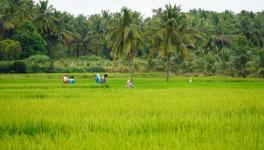Most Indian States Fail to Integrate Migrant Workers, Says Index
While states, including Kerala, Goa, Rajasthan and Andhra Pradesh, were the most successful in integrating migrant workers during 2019, crucial states with a migrant influx, including Delhi, have done poorly. The finding is courtesy the Interstate Migrant Policy Index (IMPEX) developed by the Mumbai-based research non-profit India Migration Now (IMN). It sought to measure the integration of interstate migrants.
The states’ performances have been assessed on eight policy areas spanning more than 60 policy indicators. India’s average IMPEX score in 2019 for 28 states and the Union Territory of NCT Delhi is 37 out of 100. It reflects the limited attention paid to integration efforts in the destination states. Kerala – at 57 – scored the highest, followed by Goa and Rajasthan at 51.The states of Manipur, Jharkhand, and Tripura were at the bottom, with scores of 19, 23, and 26. With a score of 34, the capital too ranked near the bottom.
The index ranks and compares all the states of India based on their migrant integration policies. According to IMN: “The comparison exercise allows for the evaluation and comparison of what state governments are doing to promote the integration of migrants in the major migrant receiving states of India.” The index addresses questions like which Indian states have the most migrant friendly policy regimes, how does India’s migration related policies compare with the rest of the world and what are the benchmarks for integration policies of internal migrants in India?
Inter-state migration is a key income generating strategy for low-income households in India. “But despite the importance of migration for a large majority of Indians, migrants continue to face significant barriers in their destination states. The impact of state borders is significant and large on migration levels within India,” the index said.
On one hand, the COVID-19 pandemic made these migrant workers visible while on the other, it intensified the challenges faced by them. This is particularly true of migrants who cross state borders for work, as more than 54 million people did as per the Census in 2011. Conversations around migrant integration – a process that involves migrants settling permanently or temporarily in destination states and interacting in many ways with receiving societies – is rarely talked about by policy makers.
There are a few central policies that exist to foster protection of migrant workers. Statutes which look after them – the Interstate Migrant Workmen (Regulation and Conditions of Service) Act 1979, the Minimum Wages Act 1948, the Contract Labour (Regulation and Abolition) Act 1970, the Equal Remuneration Act 1976, and the Building and Other Construction Workers (Regulation of Employment and Conditions of Service) Act 1996 – have now been subsumed by the new Labour Codes brought in by the Modi government.
However, state governments are responsible for a much wider range of policy areas which touch upon migrant workers’ everyday lives. The state governments also play a key role in implementing the central government's policies.
“Migration within the country is a fundamental right of every Indian citizen. However, this is seldom realised given the sedentary biases of the policies of the states,” Benoy Peter, executive director of the Centre for Migration and Inclusive Development (CMID) in Ernakulam, Kerala, told IndiaSpend.
Punjab, Haryana, Delhi, Gujarat, Maharashtra, Tamil Nadu and Kerala are the seven states which attract 51% of India’s inter-state migrants, according to an IMN analysis of Census 2011 data. Only two of these states, Kerala and Maharashtra, feature in the top 10 on IMPEX.
Delhi is the destination for six million interstate migrants according to Census. Despite the large number of migrants, it scored only 34 because benefits and policies for migrants is closely linked with domicile requirements. This is true for other popular migrant-attracting states such as Gujarat and Tamil Nadu, too. In the larger National Capital Region, consisting of Delhi-National Capital Territory and parts of Haryana and Uttar Pradesh), which received over 10 million migrants as per Census 2011, Haryana, Uttar Pradesh and Delhi rank 15th, 16th, and 17th on the index respectively.
A preference for the native population in social security schemes makes it difficult for migrants to access state insurance and healthcare schemes in different states. Enrolment for state social security schemes often require beneficiaries meeting domicile requirements.
The social security schemes are usually not portable across the state boundaries, resulting in the migrant workers losing access when they leave their home states.
Get the latest reports & analysis with people's perspective on Protests, movements & deep analytical videos, discussions of the current affairs in your Telegram app. Subscribe to NewsClick's Telegram channel & get Real-Time updates on stories, as they get published on our website.
























